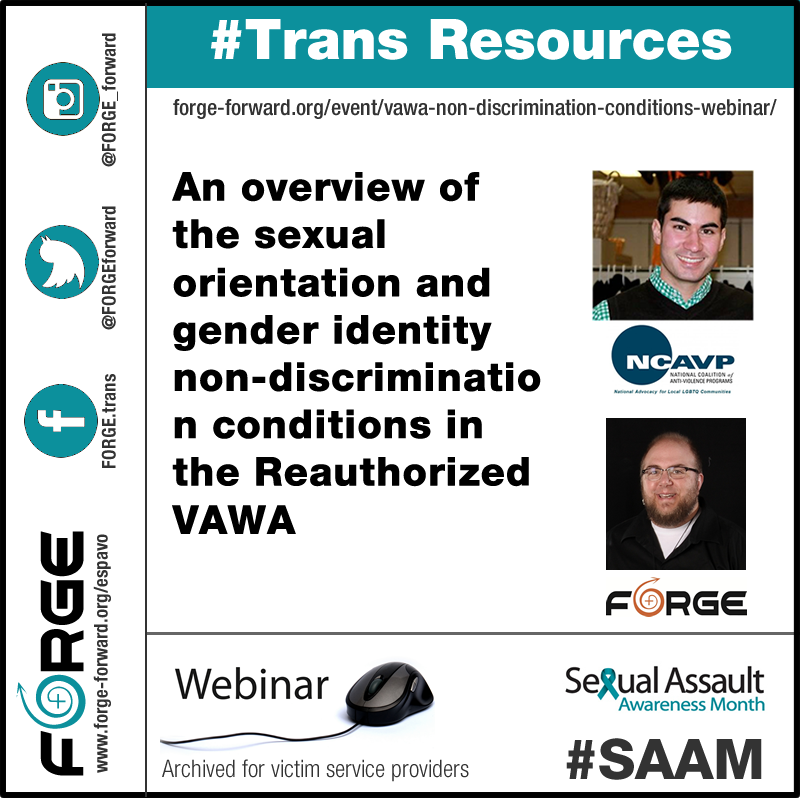Tip sheet on the Department of Justice’s Frequently Asked Questions guidance implementing new non-discrimination provisions in the Violence Against Women Act (2014).
April 9, 2014
Today the Office on Violence Against Women (OVW) released its long-awaited FAQs on how it will be implementing the new law forbidding any Violence Against Women Act (VAWA)-funded entity from discriminating on the basis of gender identity or sexual orientation.
FORGE is extremely pleased with the guidance. The following summarizes what we see as the primary ways in which the law supports transgender survivors in receiving supportive services.
Who the law covers.
The new provisions apply to any agency receiving VAWA funds after October 1, 2013, even if those funds are to augment a previously-funded project. Not only do the new provisions cover what is funded, but they will be applied to “all of the operations of a recipient, even if non-covered funds support a particular operation….Thus, a recipient that operates a program funded partially by other sources may not discriminate in any of its operations.” This includes covering State Administering Agencies and “extend(s) to the operations of other units of state government if those units also receive federal financial assistance under VAWA or are subawarded VAWA funds.”
Faith-based organizations do not have a religious exemption, except to a very limited extent when it comes to hiring people who do not share the religion being exercised by the program.
Sex-segregated and sex-specific programs.
The FAQs define programming as sex-segregated “when males and females receive services in separate settings.” Programming is sex-specific “when a recipient designs it differently for males and females.” “If the Department receives a complaint of sex discrimination based upon a recipient’s sex-segregated or sex-specific services, the onus will be on the recipient to articulate clearly why sex-segregation or sex-specific programming was necessary to the essential operations of the program” and should include reference to “established best practices and research findings.” This includes considering “the literature on the efficacy of the service being sex-segregated or sex-specific, the impact on transgender individuals seeking services, and whether similarly situated recipients providing the same services have been successful in providing services effectively in a manner that is not sex-segregated or sex-specific.”
OVW adds, “A recipient should not assume that, because services have been sex-segregated or sex-specific in the past, continued sex segregation or sex specificity is ‘necessary’ to its programming.”
Comparable services.
If sex-segregated or sex-specific programming is permitted, “comparable services” for those who are excluded must be provided: “A comparable service is one that is designed to confer a substantially equal benefit,” taking into account such factors as nature and quality of the services provided, the relative benefits of different modalities or interventions, and characteristics of the individuals who provide the service. One of OVW’s example is that if male clients are housed off-site, they must be provided transportation to supportive services that are made available on-site. In another example, “the therapeutic benefits of group counseling may be different than the therapeutic benefits of individual counseling, [so] the [agency] recipient should make every reasonable effort to provide comparable services through the same therapeutic modality.”
Placing transgender individuals in sex-segregated or sex-specific programming.
Where there are sex-segregated or sex-specific programs, transgender beneficiaries should be assigned “to the group or service which corresponds to the gender with which the beneficiary identifies,” with room to consider whether “a particular housing assignment would ensure the victim’s health and safety.” OVW cautions, however, that an agency “may not make a determination about services for one beneficiary based on the complaints of another beneficiary when those complaints are based on gender identity.” The guidance also bars agencies from “ask[ing] questions about the beneficiary’s anatomy or medical history or mak[ing] burdensome demands for identity documents.”
Enforcement mechanisms.
Both individuals and organizations or advocates may file complaints when they believe the law has been violated. Instructions and links can be found in the FAQs and at http://www.ojp.usdoj.gov/about/ocr/complaint.htm.
The 11-page FAQ is available at http://www.ovw.usdoj.gov/docs/faqs-ngc-vawa.pdf

